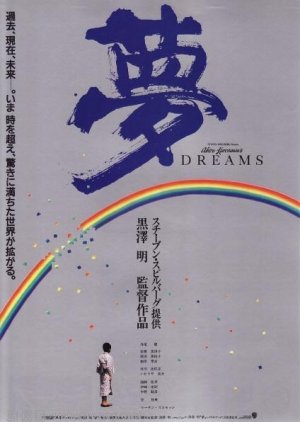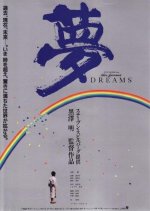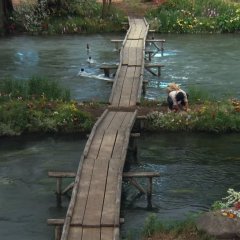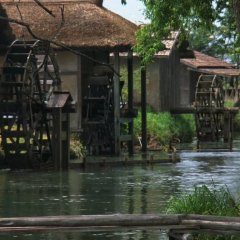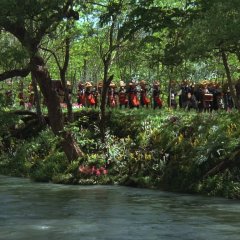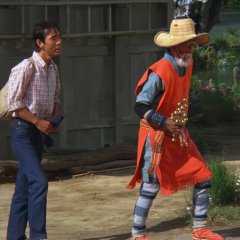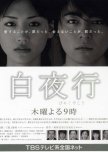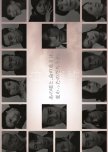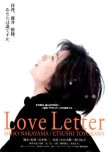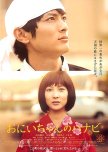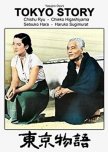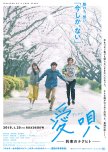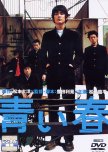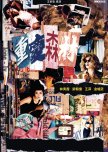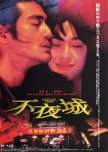- Italiano
- English
- magyar / magyar nyelv
- dansk
- Titolo Originale: 夢
- Conosciuto Anche Come: Akira Kurosawa's Dreams , I Saw a Dream Like This , Such Dreams I Have Dreamed
- Sceneggiatore & Regista: Kurosawa Akira
- Regista: Honda Ishiro
- Generi: Drama, Fantascienza, Fantasy
Cast & Ringraziamenti
- Terao AkiraIRuolo Principale
- Baisho Mitsuko[Mother of 'I']Ruolo Principale
- Negishi Toshie[Mother carrying child]Ruolo di Supporto
- Harada Mieko[The Snow Fairy]Ruolo di Supporto
- Isaki Mitsunori['I' as a boy]Ruolo di Supporto
- Igawa Hisashi[Nuclear Plant Worker]Ruolo di Supporto
Recensioni

One of the most beautiful films I've ever had the pleasure to watch. Kurosawa is a master at building such a theatre inspired aesthetic with the focus primarily on his actors performance it comes to no real surprise that the performances throughout are terrific. Split into anthology of sorts the film at times struggles to maintain a coherent tone which it's audience may struggle to adapt with. The films only real issue is that it unfortunately steps into self indulgent territory with many scenes over extending their stay, resulting in bloated sequences throughout.
| STORY |
1. Sunshine Through The Rain
Magic. An incredible reminder that dreams had in childhood can have cruel and terrifying stakes that far exceed our external world. Stunning matte paintings, too.
2. The Peach Orchard
My mouth was hanging open watching this segment. A mix of pre-pubescent mystery, wonder, and frustration. Kurosawa is on the longest of lenses, compressing his action to a completely flat plane, like a tapestry – they’re so long you can actually see heat waves shimmering in the foreground. Worth watching for this segment, alone.
3. The Blizzard
Mountaineers slowing down, stuck, fallen, and visited by a snow ghost spirit. I feel like I've had a version of this dream at some point.
4. The Tunnel
The distant glowing light of the solider's 'home' packs more poetic visual punch than a lot of entire movies do. Seems plain to me now that Kurosawa was doing the orange and teal thing before anyone else.
5. Crows
Scorsese plays Van Gogh. Love his frantic dedication to the craft - ‘not enough time, not enough time’. The drive of a locomotive. Especially surreal to see a contemporary interior in a Kurosawa movie.
6. Mount Fuji In Red
The impact of this is all in the devastating futility of the ending. I understand the enormous cultural baggage at play with the radiation here, but this is where 'Dreams' gets soggy, which is when its imagery gives way to unnecessary monologuing.
7. The Weeping Demon
Giant dandelions and writhing, tormented demons lounging by red pools. This feels like a Fringe show I saw once.
8. Village of the Watermills
More monologuing about the environment here, but ‘Village’s funereal atmosphere wraps up ‘Dreams’ in a way that closes the loop but stays ambiguous enough to make you reconsider the whole film. And then I woke up.
| ACTING/CAST |
Many of the dreams deal with loss of innocence, not only of “I” but also of Japan as the setting of the film. While the protagonist is very early on faced with death and destruction (especially of nature) which later continues with his trauma caused by the senseless deaths of his comrades during war Japan loses its innocence as well as the colors of the first dreams start to fade turning into dark tones in the later episodes until everything is wiped out during the nuclear explosions and their aftermath. This might lead to one of the reasons why it was so difficult for Kurosawa to find the money for his picture since, especially the sixth dream titled “Mount Fuji in Red”, it is highly critical of Japan embracing nuclear technology. After the war this seems to be the doom for the country as well as its people, with the toxic red gas approaching which contains plutonium as one of the last surviving humans (Hishashi Igawa) tells two others before he jumps from a cliff into a quicker death. Japan, as shown in the film, has long gone and its only choice is to find a way back before its too late.
| MUSIC/CINEMATOGRAPHY |
Dreams is a film which lives and breathes through its impressive use of color and landscape. As he has done so many times before, especially in works such as Ran, beautiful wide angle shots show nature in its entire beauty, a sight which is overwhelming at times for the observer. While in Ran the setting for the many battle scenes here it seems more peaceful – until it erupts in the sixth dream leaving the world in a desolate state with demons roaming the deserted ash fields of what once was a country. It is an idyllic setting, nature with its forest and rivers, one which is in no need for technology which, in the end, only speeds up the process of humanity's demise. It is a very didactic approach the director has chosen, but one which he expresses full of conviction.
In conclusion, Dreams is a beautiful and sometimes disturbing film about the relationship between humanity and nature as well as about a boy growing up, finding his way in life and exploring its possibilities. Using the logic of dreams each one of the episodes ends rather abruptly like waking up (sometimes form a nightmare which one would rather forget as soon as possible). It is a very personal film for its director, one with a message for its viewer which – considering the alternative he offers – sounds a bit naïve, too utopian to be precise, especially for someone who has explore the human condition in his work for most of his life.
Questa recensione ti è stata utile?

Questa recensione può contenere spoiler
"People today have forgotten that they are really just part of nature."
Over eight vignettes from Kurosawa's Dreams, you'll float through surreal settings with dolls come to life, tremble from the hellish landscape of a post-apocalyptic war and sit by a soothing river where life flows by, the past, present and future. Many of Kurosawa Akira's familiar themes run through the stories and some you may find more meaningful or interesting than others. If you've ever wanted to wander through a Van Gogh painting this is the film to do it with.Kurosawa begins the film with a wedding with possibly tragic consequences and ends the film with a joyful funeral. The old film master certainly likes to shake things up when he bookends stories. The first two dreams are when the central character standing in for Kurosawa, I, is a child. In "Sunshine Through the Rain", young I disobeys his mother and runs off to watch a Fox wedding procession leading to one of the most beautiful and disturbing scenes in the film. "Peach Orchard" has little I confronting the spirits of the peach trees his family had cut down. The spirits have taken the form of his sister's dolls and have mercy on the young boy due to his love of the lost blossoming trees. The spirits cause the trees to bloom momentarily in a most creative manner.
The next dreams feature an adult I. In "The Blizzard", four explorers are caught in a deadly snow storm. One by one, they succumb to the cold and fall asleep even as I encourages them onward. A mountain spirit attempts to lure I to sleep and he must resist or they will all die. "The Tunnel" sees I returning from WWII and walking through a long rural tunnel. He's confronted by a bloody grenade carrying anti-tank dog, then a private who had died in his arms. Finally, his whole ghost platoon confronts him. He must deal with his guilt and grief of being the only survivor as he faces his men.
In "Crows", I is an artist who travels through Van Gogh's paintings and meets the great artist. What he finds is a man driven to madness by his need to work and create the perfect paintings in his mind on the canvas. Perhaps the story is a reflection of Kurosawa and his own relentless drive to work. He too, had contemplated suicide, but went on to survive and continue his artistry.
The next two dreams are dark and as subtle as the old man in his I Fear to Live. In "Mt. Fuji in Red" Japan is ruined by the explosion of a nuclear reactor which covers the island in radioactive clouds. I and the people he is with have no place to run and one decision to make. Do they choose to die quickly or slowly? "The Weeping Demon" has I traipsing through a barren wasteland burned away by a nuclear war. The only life are giant dandelions and avaricious survivors with horns forced to devour one another to survive.
In the last dream, I crosses a narrow wooden bridge over a pristine river with waterwheels flanking both banks in "Village of the Water Mills". He comes across an old man fixing one of the wheels and discovers they use no electricity and have no need for scientific inventions. Most of the villagers live until they are very old due to their simple healthy way of life. The old man leaves I to join a rousing processional for a villager who has died, a celebration of the fulfilled life she had led. Kurosawa took us from cynicism.
Kurosawa's signature fog and wind showed up in most dreams, from the gentle rain misting in the sunshine, to the blinding blizzard on the mountain, to the colorful radioactive winds after the explosion with Mt. Fuji ablaze in orange and red. Many scenes were either brilliantly swathed in colorful flowers or menacingly gray and windy, never letting you find a comfortable place to rest.
The music and sounds further brought the scenes to life. The heavy breathing of the explorers in the howling wind, fighting for each step in the waist deep snow portrayed their desperate situation and resolve to live. Something as benign as footsteps became utterly haunting as the officer stood at the tunnel hearing the footsteps of his platoon coming toward him echoing louder and louder and later growing fainter and fainter. Several vignettes used stylized music and dancing, makeup, and costumes, reaching back into the past for inspiration.
Kurosawa covered an emotional diversity during his wedding, 2 apocalypses, and a funeral--- forgiveness, survivor's guilt, human resilience, and love for nature, as well as human greed and hubris. As he often did, he showed how the powerful materialistic upper tier with their out of control technology and self-absorption might destroy everything and everyone. Because of the captains of industry and their willful destruction of the environment they would be given a special hell to live in. Those who made friends with nature could live peacefully and well. If we take care of the environment, it will take care of us.
While I loved the sentiment of the final vignette, humankind will need to evolve much higher to do away with hate, envy, and the need for power. Inventions themselves are not always a bad thing, they can be very useful. As quickly as technology develops though so does our need for greater wisdom and love. Simply abandoning technology will not be enough.
Dreams took us on a trip through the river of time into the past, alternate planes of existence, and to possible futures. Whether this film comes across as a self-indulgent exercise by the director or a fascinating look into the beliefs about humankind and art by one of the 20th century's finest directors will be up to the individual. Even though he could be heavy handed at times or completely enigmatic I found the dreams thought provoking, creative, and a delight for the eyes.
2/17/23
Questa recensione ti è stata utile?

